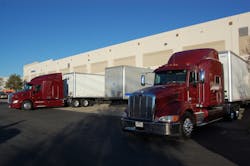“Any trucking company with 100% turnover does not have a driver shortage; they have a hell of an HR problem and that has to do with pay and benefits.” —Todd Spencer, executive vice president of the Owner-Operator Independent Drivers Association (OOIDA)
A lot’s been said about the issue of retention in the trucking industry in regards to both commercial drivers and maintenance technicians, with pay and home time at the heart of the matter where big rig operators are concerned.
Yet as the quote from OOIDA’s Todd Spencer above illustrates, an awful lot of “churn” continues to bedevil this industry, though that’s largely on the truckload side of the ledger.
[Leah Shaver, chief operating officer for the National Transportation Institute (NTI), highlighted that very trend in a recent webinar hosted by Geotab. It’s worth checking out.]
Yet motor carriers can take heart from this salient fact about their struggles with retention: many other industries are suffering from a similar problem.
In fact, a recent survey conducted by Globoforce, a so-called “social recognition solutions” provider, and the Society for Human Resource Management (SHRM) found that 46% of organizations cite employee retention as a top workforce management challenge, with more than a third (36%) highlighting “employee engagement” as another top challenge – a factor closely related to turnover.
On top of that, recruitment (34%) overtook succession planning (33%) as the third most cited organizational challenge.
Based on a poll of 798 human resource (HR) professionals employed at organizations with a staff size of 500 or more workers, the 2016 SHRM/Globoforce Employee Recognition Survey also determined that there should be “no surprise” retention is an issue when you consider Bureau of Labor Statistics data that shows the ratio of unemployed persons per job opening fell to 1.4 in September this year – nearly the lowest level since January 2001. This ratio peaked at 6.6 back in 2009 and has been steadily declining ever since, according to the report built out of this HR survey, with the number of job openings now surpassing pre-recession peaks, hitting 5.5 million three months ago.
“Why does this matter? A few years ago, workers may have tolerated a less than satisfactory experience at work for the sake of job security,” noted Eric Mosley, CEO of Globoforce, in the study. “[But] in today’s job market, all the power is in the hands of job seekers. Workers have more confidence—and more options—to look at better opportunities outside of their organization.”
He added this stark outlook as well: “We see the pillars of human capital management crumbling [with] traditional performance management practices failing to deliver on exactly what they’re meant to; measure and motivate employees.”
Here are a few of the survey’s findings along that track:
- Research from Corporate Executive Board (CEB) included in the SHRM/Globoforce report shows that the average manager spends more than 200 hours a year on activities related to performance reviews – the equivalent of 25 business days or nearly a month of work.
- When these hours are added to the cost of performance management technology, CEB estimates that a 10,000-employee company spends about $35 million per year on reviews.
- Yet some 40% of the HR professionals in the poll said they do not think performance reviews are an accurate appraisal of employees’ work. Further, another 19% said they’re “not sure” if their reviews are accurate.
- Some argued that recruiters are setting the bar too high, looking for the “purple squirrel,” as opposed to hiring for potential and then investing in training, development, and on-the-job coaching.
And here’s the kicker: in a recent report from the consulting firm Bersin by Deloitte shows that the true cost of “voluntary turnover” not only involves direct costs, like cost per hire and first-year orientation and training, but also includes the interim reduction in labor costs and lost productivity costs.
In total, Bersin by Deloitte estimates that organizations lose more than $100,000 for every employee who leaves – and this doesn’t include other indirect costs such as lost client relationships, institutional knowledge, and previous training for the employee leaving.
“In order to be successful, organizations need to win the hearts and minds of employees,” Globoforce’s Mosley said. “A more human-centric approach – where employees are treated not as human capital, but as people – fosters greater humanity and creates more positive employee experiences.”
He added that it’s also “crucial” for HR leaders to take a fresh look at compensation structures and evaluate the value they bring to employees and their respective companies.
“As our study shows, social recognition can directly impact employee experience and financial outcomes,” Mosley said.
Thoughts worth considering as trucking continues to work on its various recruiting and retention issues.

